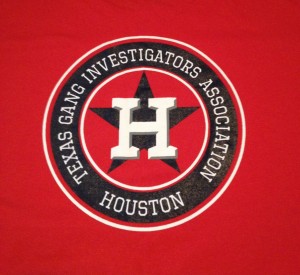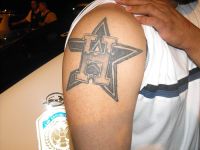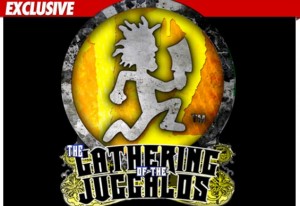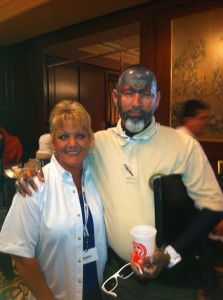Narcotics trafficking, human smuggling, weapons smuggling, home invasions, contract hits, prostitution, assault, theft, murder and prison are only part of the curriculum you undergo from the University of the Streets. In this school, passing grades on tests means you survived to live one more day. As for graduation, when you have to constantly watch your back because of the work you’re involved with, and you trust very few people (especially whatever they say), then you’ve earned an education few others will have.
Who are these graduates? They are the men and women of law enforcement and the criminal justice system who daily work in the world of violent gangs, organized crime, and prison systems. They are members of the Texas Gang Investigators Association, as well as hundreds of others across America in this field. They have my respect—and if you knew them as I do and knew what they daily endure, then they would earn yours too.
I was recently invited to the TGIA Conference in Houston to sign my books. It was my second year to be honored with an invitation by Paul Zamarripa, TGIA Director, Pos.1, South Region, and I wasn’t about to miss the opportunity. Although I never worked gangs while in law enforcement as they now do, we at least spoke a common language about the streets and life that most citizens will never comprehend, if they are fortunate. Old friends such as Patrick Natividad, TGIA 2nd Vice President, and others from last year stopped by to say hello and talk about my books they had bought. New friends were made too such as conference attendee Erik L. Larson, who I learned is also the author of “Lone Star Daybreak.”
The week-long conference always has a prestigious list of national speakers representing all levels from federal agencies to state and county offices. 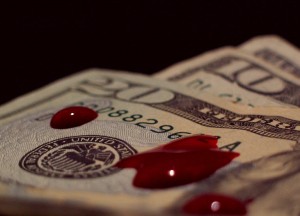 And the agenda covers—well, sorry, but that’s not open for public distribution. But, I am at liberty to discuss some of the gang related problems confronting law enforcement and our society today.
And the agenda covers—well, sorry, but that’s not open for public distribution. But, I am at liberty to discuss some of the gang related problems confronting law enforcement and our society today.
When I speak of ‘gangs’ I’m not simply talking about a group on motorcycles wearing their ‘colors,” or a group of ‘wannabe gangstas’ standing around with their baseball caps sideways, talking street trash, bobbing as they walk, and flashing gang hand-signs they made up. No, I’m discussing the organized, violent groups from Mexican drug cartels to every prison we have. They are located in rural areas, small towns, as well as major cities. These are the people psychologists would have a field day with trying to understand what makes them tick, all while our tax money and court systems must deal with their bloody crimes.
Where does the organization and leadership of these gangs stem from? Primarily, within our prisons. The prison gangs direct outside operations from the comfort of their cells. If and when released from prison, gang members connect with outside members, all while maintaining their inside connections. The majority of gangs have legitimate businesses for their money to flow through, and the spider-web of their organized crimes steadily expands right under everyone’s noses—often next door without your realization.
Where do they set up shop? Quick answer: everywhere. Operations are controlled from within our prisons, but a large segment of the gangs on the outside have left the big cities to set up shop in rural areas. Think about it a moment. Why stay in the big city where law enforcement has a multitude of resources to hound you, when you can move to smaller communities throughout the state that don’t have the budget or manpower to hamper your operations? If you stay under the radar by not drawing attention to yourself, you can do whatever you want, especially when you have the money to finance your operations. Most rural law enforcement agencies don’t have the budget to devote to a gang unit, nor are they really inclined to do so until forced into it. There is another unfortunate aspect to this too; dirty cops, those who work both sides of the street per say. I’m sorry, but it happens. Whether they were a federal agent on the border or a deputy riding desolate county roads, the intoxication of big bucks has been many a downfall.
So, who are these gangs? They are Tango Blasters, the Texas Syndicate, Barrio Azteca, the Texas Mexican Mafia, and more. The Tango Blasters were born in the 1990’s in Texas prisons and have rose to the largest gang membership. Some say 11,000 while other data places them at 14,000, even up to 100,000. To be a member, you have to have done prison time—but, there are the younger ‘Blasters’ that formed and haven’t done time yet. They want to be recognized, believe they can bypass the prison time rule for true membership, and do everything they can, drawing attention to themselves which is not the actual Tango Blaster modus operandi. Therefore, the ‘true’ Blasters have to come in, straighten them out by force, and teach them gang respect. 
The Tango Blasters are organized, yet unorganized. They don’t have a formal structure, don’t believe in having rules, no one tells anyone what to do, yet they receive directions from their leaders in prison and remain an entity. Odd, isn’t it? They don’t have a specific leader in each affiliated gang outside of prison yet they are divided into ‘Blaster’ gangs in every major Texas City: Houstone (it’s spelled this way for a reason) or “H,” Dallas or “D,” San Antonio or ‘SA,” etc.
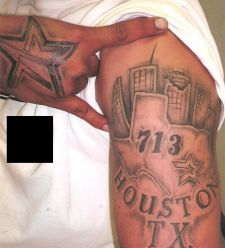 How do you recognize a Tango Blaster? This is another problem. You can’t unless you really know what you’re looking for. Their gang markings, or ‘tatts,’ are area code numbers or sports team logos of the major cities. For example, Houstone Blasters (the “e” is added on by the gang) use the Houston Astros star. They wear all the shirts and caps with the open sided star of the Astros baseball team for identification. That means they blend in with thousands of other Houstonians wearing the same regalia and tattoos! But look for the word “Houstone” and you are probably looking at a ‘Blaster.’
How do you recognize a Tango Blaster? This is another problem. You can’t unless you really know what you’re looking for. Their gang markings, or ‘tatts,’ are area code numbers or sports team logos of the major cities. For example, Houstone Blasters (the “e” is added on by the gang) use the Houston Astros star. They wear all the shirts and caps with the open sided star of the Astros baseball team for identification. That means they blend in with thousands of other Houstonians wearing the same regalia and tattoos! But look for the word “Houstone” and you are probably looking at a ‘Blaster.’
Rather than solely write about Tango Blasters, I want to mention another group I was surprised to learn of: Juggalos. Yes, you read correctly—and no, it doesn’t refer to a gang of big-breasted women.
Folks, you’re going to have to look this one up on the Internet. There are different levels of Juggalos which range from people that simply enjoy acting crazy while  dressed as a clown, to the more radical ones who cause harm and commit crimes. Yes, again you read correctly. They paint their faces in the manner of a circus clown like the Joker in a Batman movie. Their logo or image is a clown running around carrying a meat clever. Women in the group are referred to as ‘Jugga-hos’… I thought I was being kidded when a man from the State Attorney General’s office began talking about Juggalos, but the group is real. Honest. Search “Juggalos” and see what I mean. They have ‘gatherings’ which have vague resemblances to the old days of Woodstock. (Warning: If you decide to perform an online search, don’t be surprised at the photos you will see. Due to some nudity, you may not want children around your computer when you get to the ‘gathering’ photos.)
dressed as a clown, to the more radical ones who cause harm and commit crimes. Yes, again you read correctly. They paint their faces in the manner of a circus clown like the Joker in a Batman movie. Their logo or image is a clown running around carrying a meat clever. Women in the group are referred to as ‘Jugga-hos’… I thought I was being kidded when a man from the State Attorney General’s office began talking about Juggalos, but the group is real. Honest. Search “Juggalos” and see what I mean. They have ‘gatherings’ which have vague resemblances to the old days of Woodstock. (Warning: If you decide to perform an online search, don’t be surprised at the photos you will see. Due to some nudity, you may not want children around your computer when you get to the ‘gathering’ photos.)
 So, what is the answer to gang violence other than obtaining your Concealed Handgun License?
So, what is the answer to gang violence other than obtaining your Concealed Handgun License?
There are multiple answers to this. Assist and support your local law enforcement agency by reporting crimes. Educate yourself on problems in your area. Talk to your neighbors. Watch out for each other. The Houston Police Department has a gang taskforce website where information can be submitted and you can learn more about the problems: www.StopHoustonGangs.org. Start becoming aware of the crime in your community. Don’t let the sides of your building be covered in gang graffiti. Report them to the police then paint over them. It may take several coasts of paint, but eventually the gangs will stop using the sides of your building or fence as a canvas. Whether you realize it or not, the majority of the crimes you hear about on your local news broadcast are related to gangs.
Gangs are violent. They infect our society and destroy our children. Anyone can be a victim. I read a news article about a 14 year-old boy walking by a house, pulled a pistol out and shot at the man sitting on a porch, rocking an infant. The bullet struck the baby, killed him, and passed through to the father’s shoulder. The boy wanted recognition in order to join a gang.
Gangs easily reach across borders and state lines. They smuggle humans, drugs and weapons. They promote forced prostitution, make contract hits, perform violent home invasions…the list goes on.
And don’t judge a book by its cover. Simply because someone has tattoos all over their body doesn’t make them a gang member or a member of the ‘Yakuza.’ I say this because one of the conference attendees was covered with ‘tatts’ except for a small portion of his face. My friend, Rhonda Chevalier, TGIA Director, Pos.1 of the Central Region said he was one of the politest men she had ever met.
One of the best ways to keep your children out of gangs is to love them, talk to them, educate them, let them know they are important, and let them know gangs are a dead-end street. According to an old LAPD statement, 60% of gang members will be dead or in prison by age 20.
Thank you, TGIA, for sponsoring such educational law enforcement conferences. I wish every department in Texas could send at least one representative. The knowledge is valuable.
Sincerely,
Glenn
- Paul, Glenn, and Patrick.

